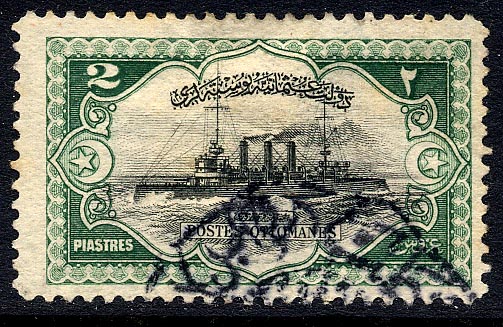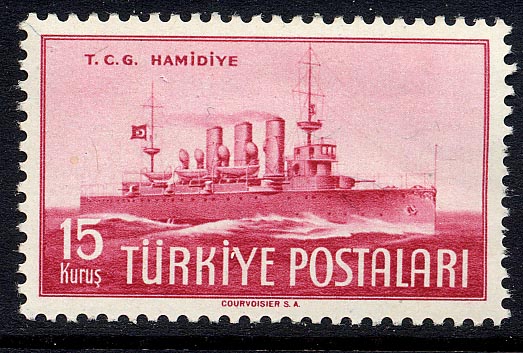Built as a cruiser under yard No 732 by Armstrong Whitworth, Elswick, U.K. for the Turkish Navy.
July 1901 ordered. She was designed by J.R.Perrett.
Her intended name was ABDUL HAMID, but if she ever carried this name is doubtful. (All the World’s Fighting Ships 1860-1905 gives that she was renamed in 1908.)
November 1902 keel laid down.
25 September 1903 launched as HAMIDIYE also given as HAMIDIEH.
Displacement 3.805 tons, dim. 112.17 x 14.5 x 4.9m. (draught).
Powered by two 4-cyl triple expansion steam engines, manufactured by R & W Hawthorn Leslie, 12.401 ihp., twin shafts, speed 22 knots.
Bunker coal capacity 275 normal, 731 tons maximum.
Range 5.500 miles by a speed of 10 knots.
Armament: 2 – 6 inch QF, 8 – 4.7 inch QF, 6 – 3pdr QF, 6 – 1pdr QF guns and 2 – 18 inch torpedo tubes.
Crew 302.
27 April 1904 final trials.
1911 She took part in the Coronation Naval Review at Spithead.
1911-1912 In the war between Italy and Turkey she played not an important role, not venturing out beyond the Dardanelles in face of a superior Italian Force.
A few days before peace was declared between Italy and Turkey, the Turkeys were again at war with the Balkan League of Montenegro, Bulgaria, Serbia and Greece.
The Turkish cruiser blockaded the Bulgarian coast; in the early morning of 22 November 1912 the HAMIDIYE was torpedoed by an 18 inch torpedo fired from an attacking Bulgarian torpedo-boat off Varna.
The HAMIDYE was hit on the starboard side forward, which blew a hole in her starboard bow of 40 by 20ft. She did not sink but managed with her fore deck submerged to steam to Constantinople.
After repair on 14 January 1913 under command of Rauf Bey she sailed from the Dardanelles for a raiding cruise in the Mediterranean see
http://www.turkeyswar.com/navy/battleships-hamidiye.htm
THE CRUISE OF HAMIDIYE
During the Balkan War, it was clear to the Turkish Naval Ministry that as long as the Greek dreadnaught AVEROF was present, there was little chance for the Turkish fleet to eliminate the smaller units of the Greek Navy. It was proposed that a cruiser should be sent to the Aegean Sea to attack Greek ports and sink merchant vessels, so that AVEROF could be drawn from the Dardanelles to chase the marauder. The job was given to HAMIDIYE. An order dated 13 January 1913 cabled to Captain Rauf Bey stated that "the decision of the High Command to send a warship on a solitary mission in order to ease the operations of the Navy has been approved by the government; HAMIDIYE has been deemed suitable for this mission, who should commence as soon as weather conditions allow."
HAMIDIYE left the home waters of the Dardanelles on 14 January 1913. The next day, she arrived at the island of Sira, where a British merchant vessel and a Greek auxiliary were anchored. HAMIDIYE sunk the Greek ship and bombarded the port. The original plan was to leave the Aegean and sail westwards to the Adriatic. However, Rauf Bey realised that the quality of the coal they had was too low and refuelling was necessary. HAMIDIYE changed direction and arrived Beyrut (Beirut) on 18 January. The next day, HAMIDIYE anchored at Port Said. Although Egypt was nominally under Turkish rule, the influence of British authorities was enough to ensure that only 150 tonnes of coal was given to HAMIDIYE although she needed 700. HAMEDIYE passed through the Suez Canal and sailed into the Red Sea.
Seeking to receive coal and communicate with the High Command in Istanbul, HAMIDIYE sailed down the Red Sea and reached Cidde on 3 February. A small amount of coal was bunkered, boiler repairs were carried out and communication with Istanbul was established. Upon consultation with the High Command, Rauf Bey prepared the plans of an expedition into the Mediterranean. HAMIDIYE was ordered to attack the Greek transportation routes off the Albanian coast, because an attempt to break through the Dardanelles was considered to be too dangerous.
HAMIDIYE was supposed to meet an Italian steamer at Malta and receive coal from that vessel. She arrived at Malta on 14 February, only to find out that the Italian steamer had already left from Beyrut. Only a limited amount of coal was bunkered from Maltese suppliers, which made operations in the Adriatic impossible. HAMIDIYE left Malta on 17 February. She arrived in Gazze (Gaza) on 22 February, without encountering the enemy as she sailed past Girit (Crete) and Korfu (Corfu). The next day, she anchored at Hayfa (Haifa) and took on 350 tonnes of coal supplied by the Hejaz Railway. From there, HAMIDIYE sailed to the Anatolian coast and arrived at Antalya.
Meanwhile, the Turkish Western army needed money and ammunition, which had to be carried to Albania. The High Command gave this mission to HAMIDIYE, which first sailed to Beyrut to bunker the coal from the Italian steamer and then to Ervat Island off the Lebanese coast to load 50 tonnes of ammunition and 10 thousand gold lira. Rauf Bey was ordered to take this cargo to Semeni River on the Albanian coast. HAMIDIYE departed on 8 March and in four days she appeared of Draç (Durazzo) where she shelled a Greek military camp. This shelling had alerted the Greek units at HAMIDIYE's second destination, Singin (Santo Giovanni di Medua), where seven Greek steamers and an Austrian ship were at anchor. Rauf Bey asked these vessels to surrender and when it was refused HAMIDIYE opened fire. Six Greek ships were sunk, one heavily damaged and the Austrian steamer beached itself. More than 120 Serbians lost their lives in the attack.
Four Greek gunboats tried to hunt HAMIDIYE in the Straits of Otranto; however the cruiser managed to escape. Only 250 tonnes of coal was left, all the ports along the Aegean Sea and the waters off the Anatolian coast were blockaded, so Rauf Bey decided to sail to Egypt. He asked the High Command to exert some pressure on the Egyptian government so that HAMIDIYE could get sufficient coal. HAMEDIYE arrived at Iskenderiye (Alexandria) on 16 March, but there was again difficulties in obtaining coal. Fortunately, the Khedive of Egypt arranged some coal to be loaded to HAMIDIYE outside the port.
Istanbul was expecting HAMIDIYE to return to Albania, however given the problems with coal and the need for refitting, Rau Bey knew that this was not possible. After cruising between Beyrut, Gazze and Hayfa for a week, HAMIDIYE went to Antalya. On 29 March, she departed again, this time to operate at the waters south of Girit (Crete). A Greek ship carrying bricks was captured and taken back to Antalya, where Rauf Bey received the news that there are some Greek warships sighted around Rodos (Rhodes) which are thought to be chasing HAMIDYE.
HAMEDIYE could only sail at a low speed because her boilers were damaged. Coal was running low and Rauf Bey also knew that the Greeks were watching the port of Beyrut, anticipating her arrival there. Meanwhile Greece had stopped all merchant shipping in East Mediterranean. After stopping in Gazze and Port Said, HAMIDIYE sailed through the Red Sea towards Cidde. Meanwhile, on 7 April, the Turkish Ministry of Navy reported the High Command about HAMIDIYE: "It would take no less than 2 months to fix HAMEDIYE's boilers. Given the state of war, refitting cannot be made in neutral ports due to international laws. The ship should sail to Cidde and wait there until the end of the war. In case if the Coal Directorate at Port Said reports the passage of the Greek fleet into the Red Sea, HAMIDIYE should then find safe haven in a neutral port."
Greeks were not intending to send their fleet to the Red Sea. On 6 April, HAMIDIYE arrived at Cidde. The Greek High Command expected her to sail back to the Mediterranean to resume operations. Three Greek warships anchored 3.5 miles off Port Said and for 45 days they waited there for HAMIDIYE which left Suez only on 19 August. She was now on her way back home. On 7 September 1913, she arrived at Istanbul, where Captain Rauf Bey and his crew received a big welcome from the population.
In his memoirs, Rauf Bey writes about a visit to Germany in 1914, where he, as the chief of staff of the Turkish Navy, and Cemal Pasa, Minister of the Navy, were received by Kaiser Wilhelm: "Cemal Pasa introduced us (to the Kaiser). First he greeted Vasif Bey and then when it was my turn he shook my hands very warmly with his both hands and said 'I followed your operation, the cruise of Hamidiye, closely. Our EMDEN tried to imitate you. However she failed. You returned to your country with glory, but they went down in Far East.' I thanked for these kind words."
29 October 1914 she shelled the Russian port of Feodosoa, and sunk two Russian vessels at Yalta.
20 November 1914 she shelled the port of Tuapse.
25 December 1914 she shelled Batumi.
During January 1915 she was intercepted twice by Russian gunboats, but escaped unscathed.
January 1915 refitted at Istanbul.
03 April 1915 she joined the MECIDIYE, and together she attacked Odessa, MECIDIYE hit a mine and sank. HAMIDIYE picked up the survivors.
30 October 1918 laid up at Istanbul.
1925 Refitted by the Turkish Navy at Golcuk.
Armament 2 – 5.9 inch 45 cal. Krupp and 8 – 3 inch 50 cal. guns.
1940 Used as a cadet training vessel.
1947 Decommissioned.
Museum ship at Istanbul from 1949 till 1951, then laid up at Istanbul.
10 September 1964 sold for scrap.
September 1964 scrapped at Pasabahoe.
Source: The mentioned URL. Warships for Export, Armstrong Warships 1867-1927 by Peter Brook.


